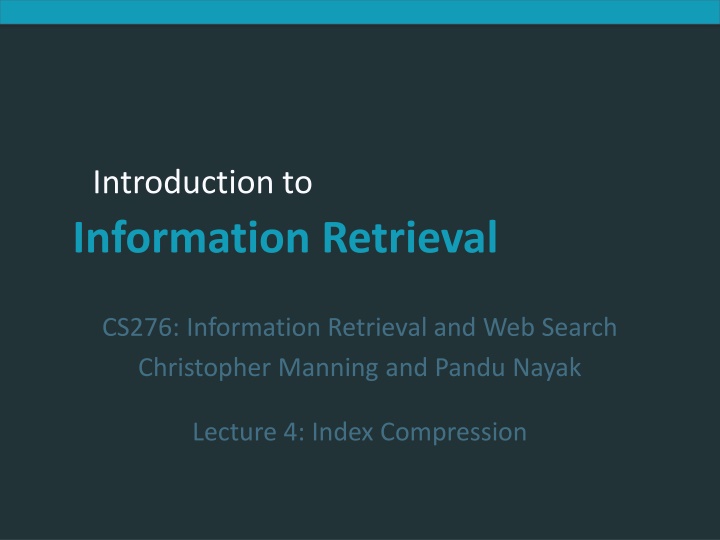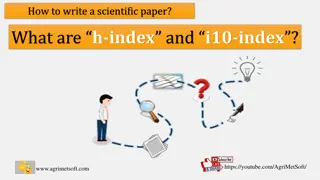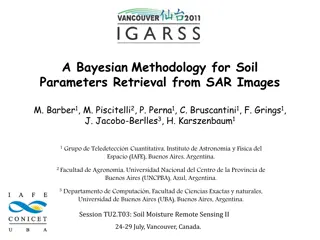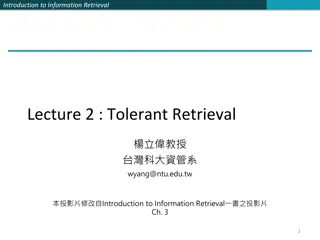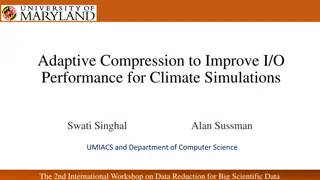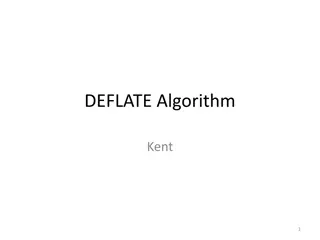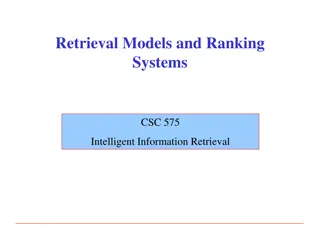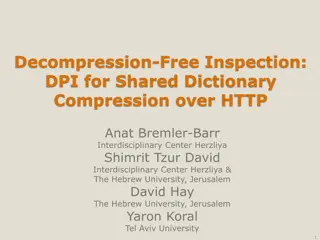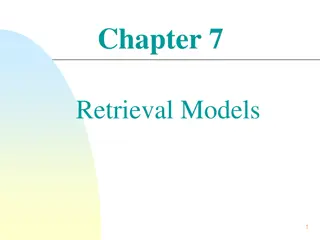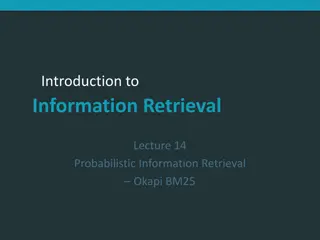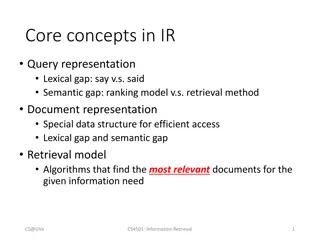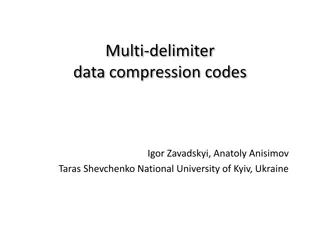Introduction to Information Retrieval: Compression Techniques and Index Optimization
Exploring concepts from information retrieval, this content delves into index compression methods such as blocked sort-based indexing and single-pass in-memory indexing. It discusses the importance of compression for inverted indexes to optimize memory usage and decrease disk space requirements, ultimately enhancing search engine efficiency.
Download Presentation

Please find below an Image/Link to download the presentation.
The content on the website is provided AS IS for your information and personal use only. It may not be sold, licensed, or shared on other websites without obtaining consent from the author.If you encounter any issues during the download, it is possible that the publisher has removed the file from their server.
You are allowed to download the files provided on this website for personal or commercial use, subject to the condition that they are used lawfully. All files are the property of their respective owners.
The content on the website is provided AS IS for your information and personal use only. It may not be sold, licensed, or shared on other websites without obtaining consent from the author.
E N D
Presentation Transcript
Introduction to Information Retrieval Introduction to Information Retrieval CS276: Information Retrieval and Web Search Christopher Manning and Pandu Nayak Lecture 4: Index Compression
Introduction to Information Retrieval Last lecture index construction Sort-based indexing Na ve in-memory inversion Blocked Sort-Based Indexing (BSBI) Merge sort is effective for hard disk based sorting (avoid seeks!) Single-Pass In-Memory Indexing (SPIMI) No global dictionary Generate separate dictionary for each block Don t sort postings Accumulate postings in postings lists as they occur Distributed indexing using MapReduce Dynamic indexing: Multiple indices, logarithmic merge 2
Ch. 5 Introduction to Information Retrieval Today Collection statistics in more detail (with RCV1) How big will the dictionary and postings be? Dictionary compression Postings compression 3
Ch. 5 Introduction to Information Retrieval Why compression (in general)? Use less disk space Save a little money; give users more space Keep more stuff in memory Increases speed Increase speed of data transfer from disk to memory [read compressed data | decompress] is faster than [read uncompressed data] Premise: Decompression algorithms are fast True of the decompression algorithms we use 4
Ch. 5 Introduction to Information Retrieval Why compression for inverted indexes? Dictionary Make it small enough to keep in main memory Make it so small that you can keep some postings lists in main memory too Postings file(s) Reduce disk space needed Decrease time needed to read postings lists from disk Large search engines keep a significant part of the postings in memory. Compression lets you keep more in memory We will devise various IR-specific compression schemes 5
Sec. 5.1 Introduction to Information Retrieval Recall Reuters RCV1 symbol N L M avg. # bytes per token (incl. spaces/punct.) avg. # bytes per token (without spaces/punct.) avg. # bytes per term non-positional postings 100,000,000 statistic documents avg. # tokens per doc terms (= word types) value 800,000 200 ~400,000 6 4.5 7.5 6
Sec. 5.1 Introduction to Information Retrieval Index parameters vs. what we index (details IIR Table 5.1, p.80) size of word types (terms) non-positional postings non-positional index positional postings dictionary positional index Size (K) % cumul % Size (K) cumul % Size (K) cumul % % % Unfiltered No numbers Case folding 30 stopwords 150 stopwords stemming 484 474 392 -17 391 391 322 -17 109,971 100,680 96,969 83,390 -14 67,002 -30 63,812 197,879 179,158 179,158 121,858 -31 94,517 -47 94,517 -2 -2 -8 -3 -8 -9 0 -9 -9 -19 -19 -19 -33 -12 -24 -39 -42 -0 -0 -38 -52 -52 -4 0 Exercise: give intuitions for all the 0 entries. Why do some zero entries correspond to big deltas in other columns? 7
Sec. 5.1 Introduction to Information Retrieval Lossless vs. lossy compression Lossless compression: All information is preserved. What we mostly do in IR. Lossy compression: Discard some information Several of the preprocessing steps can be viewed as lossy compression: case folding, stop words, stemming, number elimination. Chapter 7: Prune postings entries that are unlikely to turn up in the top k list for any query. Almost no loss of quality in top k list. 8
Sec. 5.1 Introduction to Information Retrieval Vocabulary size vs. collection size How big is the term vocabulary? That is, how many distinct words are there? Can we assume an upper bound? Not really: At least 7020 = 1037 different words of length 20 In practice, the vocabulary will keep growing with the collection size Especially with Unicode 9
Sec. 5.1 Introduction to Information Retrieval Vocabulary size vs. collection size Heaps law: M = kTb M is the size of the vocabulary, T is the number of tokens in the collection Typical values: 30 k 100 and b 0.5 In a log-log plot of vocabulary size M vs. T, Heaps law predicts a line with slope about It is the simplest possible (linear) relationship between the two in log-log space log M = log k + b log T An empirical finding ( empirical law ) 10
Sec. 5.1 Introduction to Information Retrieval Heaps Law Fig 5.1 p81 For RCV1, the dashed line log10M = 0.49 log10T + 1.64 is the best least squares fit. Thus, M = 101.64T0.49 so k = 101.64 44 and b = 0.49. Good empirical fit for Reuters RCV1 ! For first 1,000,020 tokens, law predicts 38,323 terms; actually, 38,365 terms 11
Sec. 5.1 Introduction to Information Retrieval Exercises What is the effect of including spelling errors, vs. automatically correcting spelling errors on Heaps law? Compute the vocabulary size M for this scenario: Looking at a collection of web pages, you find that there are 3000 different terms in the first 10,000 tokens and 30,000 different terms in the first 1,000,000 tokens. Assume a search engine indexes a total of 20,000,000,000 (2 1010) pages, containing 200 tokens on average What is the size of the vocabulary of the indexed collection as predicted by Heaps law? 12
Sec. 5.1 Introduction to Information Retrieval Zipf s law Heaps law gives the vocabulary size in collections. We also study the relative frequencies of terms. In natural language, there are a few very frequent terms and very many very rare terms. Zipf s law: The ith most frequent term has frequency proportional to 1/i . cfi 1/i = K/i where K is a normalizing constant cfi is collection frequency: the number of occurrences of the term ti in the collection. 13
Sec. 5.1 Introduction to Information Retrieval Zipf consequences If the most frequent term (the) occurs cf1 times then the second most frequent term (of) occurs cf1/2 times the third most frequent term (and) occurs cf1/3 times Equivalent: cfi = K/i where K is a normalizing factor, so log cfi = log K - log i Linear relationship between log cfi and log i Another power law relationship 14
Sec. 5.1 Introduction to Information Retrieval Zipf s law for Reuters RCV1 15
Ch. 5 Introduction to Information Retrieval Compression Now, we will consider compressing the space for the dictionary and postings. We ll do: Basic Boolean index only No study of positional indexes, etc. But these ideas can be extended We will consider compression schemes 16
Sec. 5.2 Introduction to Information Retrieval DICTIONARY COMPRESSION 17
Sec. 5.2 Introduction to Information Retrieval Why compress the dictionary? Search begins with the dictionary We want to keep it in memory Memory footprint competition with other applications Embedded/mobile devices may have very little memory Even if the dictionary isn t in memory, we want it to be small for a fast search startup time So, compressing the dictionary is important 18
Sec. 5.2 Introduction to Information Retrieval Dictionary storage na ve version Array of fixed-width entries ~400,000 terms; 28 bytes/term = 11.2 MB. Freq. Terms Postings ptr. a 656,265 aachen 65 . . zulu 221 20 bytes 4 bytes each Dictionary search structure 19
Sec. 5.2 Introduction to Information Retrieval Fixed-width terms are wasteful Most of the bytes in the Term column are wasted we allot 20 bytes for 1 letter terms. And we still can t handle supercalifragilisticexpialidocious or hydrochlorofluorocarbons. Written English averages ~4.5 characters/word. Exercise: Why is/isn t this the number to use for estimating the dictionary size? Ave. dictionary word in English: ~8 characters How do we use ~8 characters per dictionary term? Short words dominate token counts but not type average. 20
Sec. 5.2 Introduction to Information Retrieval Compressing the term list: Dictionary-as-a-String Store dictionary as a (long) string of characters: Pointer to next word shows end of current word Hope to save up to 60% of dictionary space .systilesyzygeticsyzygialsyzygyszaibelyiteszczecinszomo . Freq. Postings ptr. Term ptr. Total string length = 400K x 8B = 3.2MB 33 29 44 Pointers resolve 3.2M positions: log23.2M = 22bits = 3bytes 126 21
Sec. 5.2 Introduction to Information Retrieval Space for dictionary as a string 4 bytes per term for Freq. 4 bytes per term for pointer to Postings. 3 bytes per term pointer Avg. 8 bytes per term in term string 400K terms x 19 7.6 MB (against 11.2MB for fixed width) Now avg. 11 bytes/term, not 20. 22
Sec. 5.2 Introduction to Information Retrieval Blocking Store pointers to every kth term string. Example below: k=4. Need to store term lengths (1 extra byte) .7systile9syzygetic8syzygial6syzygy11szaibelyite8szczecin9szomo . Freq. Postings ptr. Term ptr. 33 Save 9 bytes on 3 pointers. 29 Lose 4 bytes on term lengths. 44 126 7 23
Sec. 5.2 Introduction to Information Retrieval Blocking Net Gains Example for block size k = 4 Where we used 3 bytes/pointer without blocking 3 x 4 = 12 bytes, now we use 3 + 4 = 7 bytes. Shaved another ~0.5MB. This reduces the size of the dictionary from 7.6 MB to 7.1 MB. We can save more with larger k. Question: Why not go with larger k? 24
Sec. 5.2 Introduction to Information Retrieval Dictionary search without blocking Assuming each dictionary term equally likely in query (not really so in practice!), average number of comparisons = (1+2 2+4 3+4)/8 ~2.6 Exercise: what if the frequencies of query terms were non-uniform but known, how would you structure the dictionary search tree? 25
Sec. 5.2 Introduction to Information Retrieval Dictionary search with blocking Binary search down to 4-term block; Then linear search through terms in block. Blocks of 4 (binary tree), avg. = (1+2 2+2 3+2 4+5)/8 = 3 compares 26
Sec. 5.2 Introduction to Information Retrieval Exercises Estimate the space usage (and savings compared to 7.6 MB) with blocking, for block sizes of k = 4, 8 and 16. Estimate the impact on search performance (and slowdown compared to k=1) with blocking, for block sizes of k = 4, 8 and 16. 27
Sec. 5.2 Introduction to Information Retrieval Front coding Front-coding: Sorted words commonly have long common prefix store differences only (for last k-1 in a block of k) 8automata8automate9automatic10automation 8automat*a1 e2 ic3 ion Extra length beyond automat. Encodes prefix automat Begins to resemble general string compression. 28
Sec. 5.2 Introduction to Information Retrieval RCV1 dictionary compression summary Technique Size in MB Fixed width 11.2 Dictionary-as-String with pointers to every term 7.6 + blocking, k = 4 7.1 + blocking + front coding 5.9 29
Sec. 5.3 Introduction to Information Retrieval POSTINGS COMPRESSION 30
Sec. 5.3 Introduction to Information Retrieval Postings compression The postings file is much larger than the dictionary, factor of at least 10, often over 100 times larger Key desideratum: store each posting compactly. A posting for our purposes is a docID. For Reuters (800,000 documents), we would use 32 bits per docID when using 4-byte integers. Alternatively, we can use log2800,000 20 bits per docID. Our goal: use far fewer than 20 bits per docID. 31
Sec. 5.3 Introduction to Information Retrieval Postings: two conflicting forces A term like arachnocentric occurs in maybe one doc out of a million we would like to store this posting using log21M 20 bits. A term like the occurs in virtually every doc, so 20 bits/posting 2MB is too expensive. Prefer 0/1 bitmap vector in this case ( 100K) 32
Sec. 5.3 Introduction to Information Retrieval Gap encoding of postings file entries We store the list of docs containing a term in increasing order of docID. computer: 33,47,154,159,202 Consequence: it suffices to store gaps. 33,14,107,5,43 Hope: most gaps can be encoded/stored with far fewer than 20 bits. Especially for common words 33
Sec. 5.3 Introduction to Information Retrieval Three postings entries 34
Sec. 5.3 Introduction to Information Retrieval Variable length encoding Aim: For arachnocentric, we will use ~20 bits/gap entry. For the, we will use ~1 bit/gap entry. If the average gap for a term is G, we want to use ~log2G bits/gap entry. Key challenge: encode every integer (gap) with about as few bits as needed for that integer. This requires a variable length encoding Variable length codes achieve this by using short codes for small numbers 35
Introduction to Information Retrieval Unary code Represent n as n 1s with a final 0. Unary code for 3 is 1110. Unary code for 40 is 11111111111111111111111111111111111111110 . Unary code for 80 is: 11111111111111111111111111111111111111111111 1111111111111111111111111111111111110 This doesn t look promising, but . Optimal if P(n) = 2 n We can use it as part of our solution 36
Sec. 5.3 Introduction to Information Retrieval Gamma codes We can compress better with bit-level codes The Gamma code is the best known of these. Represent a gap G as a pair length and offset offset is G in binary, with the leading bit cut off For example 13 1101 101 length is the length of offset For 13 (offset 101), this is 3. We encode length with unary code: 1110. Gamma code of 13 is the concatenation of length and offset: 1110101 37
Sec. 5.3 Introduction to Information Retrieval Gamma code examples -code number length offset 0 1 2 3 4 9 none 0 0 10 10 110 1110 1110 11110 0 1 10,0 10,1 00 001 101 1000 110,00 1110,001 1110,101 11110,1000 13 24 511 1025 111111110 11111111110 11111111 0000000001 111111110,11111111 11111111110,0000000001 38
Introduction to Information Retrieval Reminder: bitwise operations For compression, you need to use bitwise operators Python (and most everything else): & bitwise and; | bitwise or; ^ bitwise xor; ~ ones complement << left shift bits, >> right shift; LACKS >>> zero fill right shift Recipes: Extract 7 bits: a & 0x7f00 >> 8 ; if take high-order bit add: & 0x7f Combine 3 5-bit numbers: a | (b << 5) | (c << 10) Lookup tables rather than decoding can be faster, yet still small 39
Sec. 5.3 Introduction to Information Retrieval Gamma code properties G is encoded using 2 log G + 1 bits Length of offset is log G bits Length of length is log G + 1 bits All gamma codes have an odd number of bits Almost within a factor of 2 of best possible, log2G Gamma code is uniquely prefix-decodable, like VB Gamma code can be used for any distribution Optimal for P(n) 1/(2n2) Gamma code is parameter-free 40
Sec. 5.3 Introduction to Information Retrieval Gamma seldom used in practice Machines have word boundaries 8, 16, 32, 64 bits Operations that cross word boundaries are slower Compressing and manipulating at the granularity of bits can be too slow All modern practice is to use byte or word aligned codes Variable byte encoding is a faster, conceptually simpler compression scheme, with decent compression 41
Sec. 5.3 Introduction to Information Retrieval Variable Byte (VB) codes For a gap value G, we want to use close to the fewest bytes needed to hold log2 G bits Begin with one byte to store G and dedicate 1 bit in it to be a continuation bit c If G 127, binary-encode it in the 7 available bits and set c =1 Else encode G s lower-order 7 bits and then use additional bytes to encode the higher order bits using the same algorithm At the end set the continuation bit of the last byte to 1 (c =1) and for the other bytes c = 0. 42
Sec. 5.3 Introduction to Information Retrieval Example docIDs gaps VB code 824 829 5 10000101 215406 214577 00001101 00001100 10110001 00000110 10111000 Postings stored as the byte concatenation 000001101011100010000101000011010000110010110001 Key property: VB-encoded postings are uniquely prefix-decodable. For a small gap (5), VB uses a whole byte. 43
Sec. 5.3 Introduction to Information Retrieval RCV1 compression Data structure dictionary, fixed-width dictionary, term pointers into string with blocking, k = 4 with blocking & front coding collection (text, xml markup etc) collection (text) Term-doc incidence matrix postings, uncompressed (32-bit words) postings, uncompressed (20 bits) postings, variable byte encoded postings, encoded Size in MB 11.2 7.6 7.1 5.9 3,600.0 960.0 40,000.0 400.0 250.0 116.0 101.0 44
Sec. 5.3 Introduction to Information Retrieval Other variable unit codes Variable byte codes are used by many real systems Good low-tech blend of variable-length coding and sensitivity to computer memory alignment matches Byte alignment wastes space if you have many small gaps as gap encoding often makes More modern work mainly uses the ideas: Be word aligned (32 or 64 bits; even faster) Encode several gaps at the same time Often assume a maximum gap size, perhaps with an escape 45
Introduction to Information Retrieval Group Variable Integer code Used by Google around turn of millennium . Jeff Dean, keynote at WSDM 2009 and presentations at CS276 Encodes 4 integers in blocks of size 5 17 bytes First byte: four 2-bit binary length fields , Lj {1,2,3,4} Then, L1+L2+L3+L4 bytes (between 4 16) hold 4 numbers Each number can use 8/16/24/32 bits. Max gap length ~4 billion It was suggested that this was about twice as fast as VB encoding Decoding gaps is much simpler no bit masking First byte can be decoded with lookup table or switch L1L2L3L4 46
Introduction to Information Retrieval Simple-9 [Anh & Moffat, 2004] A word-aligned, multiple number encoding scheme How can we store several numbers in 32 bits with a format selector? 28 1-bit numbers 14 2-bit numbers 9 3-bit numbers 7 4-bit numbers selectors (9 total ways)
Introduction to Information Retrieval Simple9 Encoding Scheme [Anh & Moffat, 2004] Encoding block: 4 bytes (32 bits) Most significant nibble (4 bits) describe the layout of the 28 other bits as follows: 0: a single 28-bit number 1: two 14-bit numbers 2: three 9-bit numbers (and one spare bit) 3: four 7-bit numbers 4: five 5-bit numbers (and three spare bits) 5: seven 4-bit numbers 6: nine 3-bit numbers (and one spare bit) 7: fourteen two-bit numbers 8: twenty-eight one-bit numbers Simple16 is a variant with 5 additional (uneven) configurations Efficiently decoded with hand-coded decoder, using bit masks Extended Simple Family idea applies to 64-bit words, etc. n numbers of b bits each n * b 28 Layout (4 bits) 48
Sec. 5.3 Introduction to Information Retrieval Index compression summary We can now create an index for highly efficient Boolean retrieval that is very space efficient Only 4% of the total size of the collection Only 10-15% of the total size of the text in the collection We ve ignored positional information Hence, space savings are less for indexes used in practice But techniques substantially the same 49
Ch. 5 Introduction to Information Retrieval Resources for today s lecture IIR 5 MG 3.3, 3.4. F. Scholer, H.E. Williams and J. Zobel. 2002. Compression of Inverted Indexes For Fast Query Evaluation. Proc. ACM-SIGIR 2002. Variable byte codes V. N. Anh and A. Moffat. 2005. Inverted Index Compression Using Word-Aligned Binary Codes. Information Retrieval 8: 151 166. Word aligned codes 50
